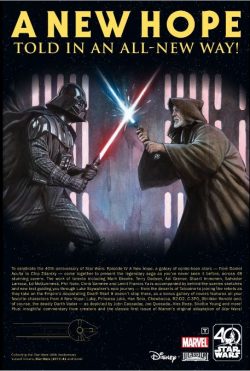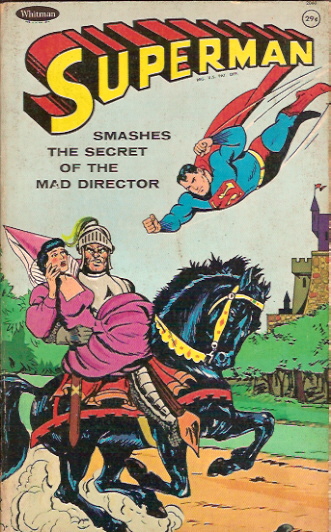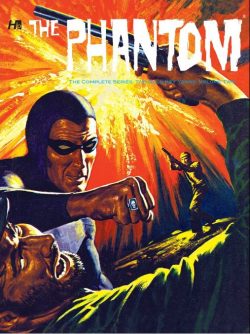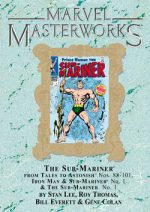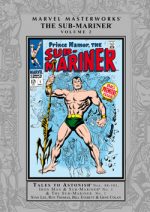
By Jim Starlin, Mike Friedrich, Steve Englehart, Steve Gerber, Scott Edelman, Don Heck, Bob Brown, John Buscema, Mike Zeck & various (Marvel)
ISBN: 978-0-7851-6850-8
With another Marvel Cinematic Universe film scoring big around the world, here’s a timely trade paperback and eBook edition to augment the celluloid exposure and cater to movie fans wanting to follow up with a comics experience that fills in all the gaps.
After Marvel mainstays Steve Ditko and Jack Kirby left the company, the burgeoning publisher brought in a raft of young newcomers to fill the void. One of the most successful of these was Jim Starlin who especially rose to the occasion by masterminding a vast and sprawling cosmic epic using a constantly failing property various stalwarts of the House of Ideas could not make a hit…
Captain Marvel was an alien on Earth, a defector from the militaristic Kree empire who fought for Earth and was atomically bonded to professional sidekick Rick Jones by a pair of wristbands allowing them to share the same space in our universe. When one was here, the other was trapped in the antimatter dimension designated the Negative Zone.
After meandering around the Marvel Universe for a while, continually one step ahead of cancellation (the series had folded many times, but always quickly returned – primarily to secure the all-important trademark name), Mar-Vell was handed to Starlin – and the young craftsman was left alone to get on with it.
With many of his fellow neophytes he began laying seeds (particularly in Iron Man, Sub-Mariner and Daredevil) for a saga that would in many ways become as well-regarded as the Jack Kirby Fourth World Trilogy that inspired it.
However, the Thanos War, despite many superficial similarities, would soon develop into a uniquely modern experience. And what it lacked in grandeur it made up for with sheer energy and enthusiasm…
Spanning February 1973-September 1974, this grandiose compendium (available in Trade Paperback and eBook editions) gathers and chronologically collates Iron Man #55, Captain Marvel #25-33, Marvel Feature #12, Daredevil #105-107, Avengers #125, Warlock #9-11 and 15, Avengers Annual #7, Marvel Two-in-One Annual #2 and concludes with a pertinent back-up from Logan’s Run #6 (June 1977: re-presenting Starlin’s entire early development of and engagement with one of comicbooks’ most popular villains.
The artistic iconoclasm began in Iron Man #55 (February 1973) where Mike Friedrich scripted Starlin’s opening gambit in a cosmic epic that would change the nature of Marvel itself.
Inked by Mike Esposito, ‘Beware… Beware… Beware the … Blood Brothers!’ introduces formidable and obsessive Drax the Destroyer; an immensely powerful humanoid trapped under the Nevada desert and in dire need of rescue by even more potent extraterrestrial invader Thanos…
That comes when the Armoured Avenger blazes in, answering a mysterious SOS, but only after brutally dealing with the secret invader’s bombastic and brutal underlings…
All this is merely a prelude to the main story which starts unfolding a month later in Captain Marvel #25, courtesy of Friedrich, Starlin, & Chic Stone, wherein Thanos unleashes ‘A Taste of Madness!’, changing exiled Mar-Vell’s fortunes forever…
When Mar-Vell is ambushed by a pack of extraterrestrial assassins, he is forced to admit that his powers have been in decline for some time. Unaware that an unseen foe is counting on that, Rick manifests from the Negative Zone to check in with sagacious scientific maverick Dr. Savannah, only to find himself accused by the savant’s daughter (and Rick’s beloved) Lou-Ann of her father’s murder…
Hauled off to jail, Rick brings in Mar-Vell who is suddenly confronted by a veritable legion of old foes before deducing who in fact his true enemies are…
Issue #26 then sees Rick freed from police custody to confront Lou-Ann over her seeming ‘Betrayal!’ (Starlin, Friedrich & Dave Cockrum). Before long, though, he and Mar-Vell realise they are the targets of psychological warfare: the girl is being mind-controlled whilst Super Skrull and his hidden “Masterlord†are manipulating them and others in search of a lost secret…
When a subsequent scheme to have Mar-Vell murder The Thing spectacularly fails, Thanos takes personal charge. The Titan is hungry for conquest and needs Rick because his subconscious conceals the location of an irresistible ultimate weapon.
Rick awakens to find himself ‘Trapped on Titan!’ (Pablo Marcos inks) not realising the villain has already extracted the location of a reality-altering Cosmic Cube from him. Rescued by Thanos’ hyper-powered father Mentor and noble brother Eros, the horrified human lad sees first-hand the extent of the genocide the death-loving monster has inflicted upon his own birthworld. Appalled and angry, Rick summons Captain Marvel to wreak vengeance…
Meanwhile on Earth, still-enslaved Lou-Ann has gone to warn the Mighty Avengers and summarily collapsed. By the time Mar-Vell arrives in #28 she lies near death. ‘When Titans Collide!’ (inks by Dan Green) reveals another plank of Thanos’ plan.
As the heroes are picked off by psychic parasite The Controller, the Kree Captain is assaulted by bizarre visions of an incredibly ancient being. Fatally distracted, he becomes the malevolent mind-leech’s latest conquest…
Al Milgrom inks ‘Metamorphosis!’ as Mar-Vell’s connection to Rick is severed before the Kree exile is transported to an otherworldly locale where a grotesque eight billion-year-old being named Eon reveals the origins of universal life whilst overseeing the abductee’s forced evolution into an ultimate warrior: a universal champion gifted with the subtly irresistible power of Cosmic Awareness…
Subsequently returned to Earth and reconnected to his frantic atomic counterpart, the newly-appointed “Protector of the Universe†confronts The Controller, thrashing the monumentally powerful brain-parasite in a devastating display of skill countering exo-skeletal super-strength in #30’s ‘…To Be Free from Control!’
Iron Man, meanwhile, has recovered from a previous Controller assault and headed for Marvel Feature #12 to join Ben Grimm in ending a desert incursion by Thanos’ forces before enduring ‘The Bite of the Blood Brothers!’ (Friedrich, Starlin, & Joe Sinnott), after which the story develops through the unseeing eyes of San Francisco-based swashbuckler Daredevil.
In DD #105, Matt Murdock has realised his new boss Kerwin Broderick has been sabotaging the attorney’s cases, and even hired warped mercenary Sergei Kravinoff AKA Kraven the Hunter to crush Daredevil’s investigative interference. When Kraven abducts his lover The Black Widow, the hero tries to save her but is thrown to his death over a cliff…
Natasha brutally avenge her man’s murder, but Murdock is far from dead, having being teleported from the jaws of doom by a ‘Menace from the Moons of Saturn!’ (scripted by Steve Gerber with art by Don Heck & Don Perlin).
In a short sequence pencilled by Starlin, the earthborn Priestess of Titan reveals how she had been dispatched to Earth to counter the schemes of death-worshipping proto-god Thanos.
Here the formerly enigmatic and emotionless super scientist Madame MacEvil shares her origins and foreshadows her future role in the cosmic catastrophe to come.
When Thanos killed her family, the infant Heather Douglas was adopted by Mentor, taken to Titan and reared by psionic martial artists of the Shao-Lom Monastery. Years later when Thanos attacked Titan and destroyed the monks she swore revenge and took a new name… Moondragon.
She also inadvertently discloses how she had innocently allied with a respected man of power and authority, providing him with a variety of augmented agents such as Dark Messiah, Ramrod and Angar …in fact all the menaces who have recently dogged the Man Without Fear…
Gerber, Heck & Trapani then brought the expansive sidebar saga closer to culmination as the manipulator is unmasked in ‘Life Be Not Proud!’ but not before the wily plotter redeploys all his past minions, shoots his misguided ally Moondragon, usurps a Titanian ultimate weapon and unleashes a life-leeching horror dubbed Terrex upon the world.
With all Earth endangered, DD, the Widow and guest-star Captain Marvel are forced to pull out all the stops to defeat the threat, and only then after a last-minute defection by the worst of their enemies and a desperate ‘Blind Man’s Life!’ courtesy of Gerber, Bob Brown & Sal Buscema.
Inked by Green & Milgrom, Captain Marvel #31 announces ‘The Beginning of the End!’ as the Avengers – in a gathering of last resort – are joined by psionic priestess Moondragon and Drax: revealed as one more of Thanos’ victims but one recalled from death by supernal forces to hunt and destroy the deranged Titan…
Thanos is then revealed as a lover of the personification of Death: determined to gift her Earth as a betrothal present. To that end he uses the Cosmic Cube to turn himself into ‘Thanos the Insane God!’ (Green inks) who, with a casual thought, imprisons all opposition to his reign.
The story then slips into Avengers #125, as Thanos unleashes ‘The Power of Babel!’ (Steve Englehart, John Buscema & Cockrum) with his vast alien armada bombarding Earth. In combating it, the Earth’s Mightiest Heroes are trapped out of phase with their home-world and, on defeating the star raiders, can only watch helplessly as ghosts in another dimension…
All seems lost but the Titan’s insane arrogance leaves the cosmically aware Mar-Vell with one slim chance to undo every change. Brilliantly outmanoeuvring the omnipotent ogre, the Kree Captain defeats and apparently destroys ‘The God Himself!’ in cosmically climatic Captain Marvel #33 (inked by Klaus Janson).
With the menace removed life returned to hectic normality, but the threat of Thanos had not ended.
While the war unfolded on Earth, Avatar of Life Adam Warlock had been making his way across the cosmos. The man-made man-god origins were as a lab experiment concocted by rogue geneticists eager to create a superman they could control for conquest. After facing the Fantastic Four, “Him†subsequently escaped to the stars before returning to his all-encompassing cocoon to evolve a little more.
That stellar shell was picked up by the moon-sized ship of self-created deity the High Evolutionary who was wrapped up in a bold new experiment. The naive wanderer observed as the Evolutionary created a duplicate Earth on the far side of the sun, running through billions of years of evolution in mere hours.
The intent was to create a civilisation without aggression or rancour, but the Evolutionary collapsed from exhaustion just as proto-hominid became Homo Sapien and his greatest mistake took instant advantage of the fact…
Years previously Man-Beast had been hyper-evolved from a wolf and instantly became his creator’s nemesis. Now he and his equally debased minions invaded the ship and interfered with the experiment: reintroducing evil to the perfect creatures below and, in fact, making them just like us. At incredible speed Earth’s history re-ran with the creature in the cocoon afforded a ring-side seat to humanity’s fall from grace…
When the High Evolutionary awoke and fought Man-Beast’s army, Him broke out of his shell and helped rout the demons, who fled to the despoiled Counter-Earth. With calm restored, the science-god sought to sterilise his ruined experiment: a world now indistinguishable from our own. No superheroes; disease and poverty rampant; injustice in ascendance and moments away from nuclear Armageddon… but Him begged him not to.
Claiming the evil tide could be turned, he begged the Evolutionary to stay his hand. The grieving, despondent creator agreed… but only until the rechristened Adam Warlock should admit that humanity was beyond redemption…
After failing in that endeavour Warlock travelled to the furthest reaches of creation only to discover a cruel and rapacious Universal Church of Truth slaughtering billions and learned with horror that the faith was based on a living god: his own evil future self The Magus.
Resolved to destroy the vile aberration he partnered with a troll named Pip and an assassin named Gamora, unaware that she actually worked for a hidden masterlord with a devilish agenda of his own…
Taken from Warlock #9-11 (October 1975-February 1976) the culmination of that struggle began with ‘The Infinity Effect’ (Starlin & Steve Leialoha) as the triumphant Magus easily countered every desperate ploy of Warlock to avoid an imminent metamorphosis into his malignant future self. All hope seems lost until Gamora’s master finally intercedes…
‘How Strange My Destiny!’ finds the unflappable Magus respond by setting 25,000 super-powered religious fanatics on the Warlock and Thanos as a way of keeping them occupied until the inevitable transformation occurs. ‘Enter the Redemption Principle!’ finds Magus at last rattled and personally intervening…
Issue #12’s sees an ‘Escape into the Inner Prison!’ as Warlock discovers that his ally is the Avatar of Death, just as the Magus has usurped his own position as Avatar of Life. With no other option he chooses to circumvent an intolerable fate with ‘The Strange Death of Adam Warlock!’…
After months more purposeless adventuring for Adam, infinitely patient Thanos at last shares his ultimate plans with devoted disciple Gamora. With Starlin handling all the creative chores, ‘Just a Series of Events!’ in Warlock #15 follows the artificial angel as he meanders towards his ultimate end and reveals that the all-powerful Soul Gem he wears on his brow is more his parasitic master than faithful servant…
That leads directly into a brace of 1977 Annuals which promised to resolve the Thanos/Warlock conflict forever. ‘The Final Threat’ (Starlin & Joe Rubinstein), from Avengers Annual #7, saw Captain Marvel and Moondragon return to Earth with vague anticipations of an impending cosmic catastrophe.
Their premonitions are confirmed when galactic wanderer Adam Warlock arrives with news that death-obsessed Thanos has amassed an alien armada and built a Soul-Gem powered cannon to snuff out the stars like candles…
Broaching interstellar space to stop the scheme, the united heroes forestall the stellar invasion and prevent the Dark Titan from destroying the Sun – but only at the cost of Warlock’s life…
Then ‘Death Watch!’ (Starlin & Rubinstein, Marvel Two-in-One Annual #2) finds Peter Parker plagued by prophetic nightmares, disclosing how Thanos had snatched victory from defeat and now holds the Avengers captive whilst he again prepares to extinguish Sol.
With nowhere else to turn, the anguished, disbelieving Spider-Man heads for the Baxter Building, hoping to borrow a spacecraft, and unaware that The Thing also had a history with the terrifying Titan.
Although utterly overmatched, the mismatched substitute-champions of Life subsequently upset Thanos’ plans enough so that the Avengers and the Universe’s true agent of retribution are able to end the Titan’s threat forever… or at least until next time…
That ought to be the end of this first cycle of cosmic conflagration but there’s still one more treat on offer here.
Logan’s Run was a short-lived licensed property tie-in and #6 incongruously featured a 5-page filler short starring Thanos in battle against his precision-crafted nemesis Drax the Destroyer: a typically inconclusive out-world clash over ‘The Final Flower’ by Scott Edelman & Mike Zeck.
A timeless classic of the company and the genre, made topical by the latest Marvel Cinematic Universe extravaganza, this is a tale no full-blooded print or screen-based Fights ‘n’ Tights fan can be without.
© 1972, 1973, 1974, 1975, 1976, 1977, 2013, 2018 Marvel Characters, Inc. All rights reserved.


